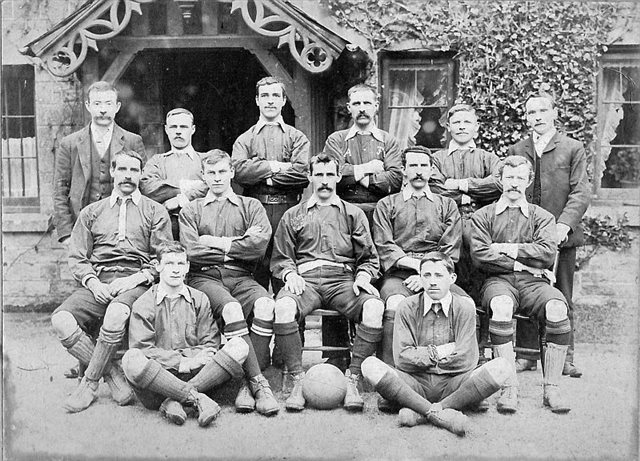Social Life in the Old Days
It is tempting nowadays, especially for the young, to winder how on earth people kept themselves amused before they had the TV or the radio. The answer, of course, is that they were much better at providing their own entertainments. I want to explore in some detail the variety of social activities and amusements in Penallt at the turn of the last century and the early years of this.
The biggest affairs, naturally, were in celebration of major events such as Queen Victoria’s Diamond Jubilee in 1897. On that occasion 200 people dined in a marquee at Moorcroft after walking in procession from a thanksgiving service at St Mary’s, led by Whitelye Brass Band. Sports and tea for 90 children followed, with fireworks as the finale.

In the following month the Church choir were given a special treat, no doubt to mark Jubilee year: an outing by train to Chepstow and Newport and then on the SS ‘Scotia’ to Weston-super-Mare. For some of them it may well have been their first experience of the sea. The Baptist Sunday School countered soon after with a trip to Cheltenham by train, going via Chepstow and returning through Ross (a journey which railway enthusiasts would dearly love to be able to make today). The Church Sunday School, in the same week, were less adventurous. Led by Mrs Pelham of Moorcroft and Mrs Goldney, the Vicar’s wife, they had to be content with a picnic at Penyvan, to which they travelled in two farm waggons lent for the occasion.
The churches were the principal village organisations – indeed almost the only permanent ones apart from the school – in those days, with the Baptists and Methodists far stronger than they are today; all three churches gave regular Christmas parties and various entertainments at other times. Music was a regular feature of all such gatherings, with songs, instrumental numbers and recitations provided by the people themselves, both adults and children.
George Bernard Shaw, a frequent guest at the Argoed in the 1890s, wrote a newspaper article about a concert he attended here and gave high praise to the musical talents of Penallt (quoted in the article ‘Penallt in 1894’). This tradition was continued, and in 1919 the Whitebrook and District Choral Society was formed with Ernest Pick as its conductor and three other Picks in the choir as well as members of the Vaughan, Williams and Roberts families from Penallt. Informal musical evenings continued to be a regular feature of parish life throughout the 1920s and 1930s. Some of the entertainments were fund-raising events, as when Miss May Haskins brought the Monmouth Pierrots in 1919 to perform in aid of the ‘Welcome Home Fund’ for returning ex-servicemen. In the following year a Baptist concert raised £11 12s 0d and in 1921 Mrs Beyts (daughter of Mr Chatfield of the Argoed) organised an entertainment which raised £18 from two performances. When one notes that the combined collections from the ‘well-attended’ Harvest thanksgiving Services at the Old Church and St Mary’s in that same year totalled £2 4s 3d, one can only conclude that ‘show business’, then as now, was a mighty money-spinner!
Dances were held at times, including one to raise money for the Jubilee celebrations in 1897, with music provided by melodeon and piano. On Boxing Night in 1929 there was a fancy dress dance, the costumes judged by Mr and Mrs Beyts. Plays were produced, by the schoolchildren among others. In 1915 they put on a play called ‘Jan of Windmill Land’ under the direction of Miss Bishop, the headmistress, and her two assistants, Miss Sylvanus-Jones and Miss Herbert*. In that year, incidentally, the schoolchildren contributed £5 3s 0d to War Charities.
Turning to outdoor events, flower shows, fetes and sports days were very important occasions, organised annually by the Methodists as well as the Church. The Flower Show and Sports at the Argoed in august 1920 were the first to be held since before the Great War. Among the prize-winners recorded were Mr Arthur du Heaume, who also helped to organise the sports, and Mr Ray Morgan (in the children’s classes). In 1922 the Vicarage Fete was opened by Mrs Tweedy, the Lady of the Manor. As for organised team sports, there was a football eleven, and the Pelhams had formed a cricket team in 1880s, and provided ground and equipment. Presumably grounds were either scythed or grazed down to the correct texture! 1921 was a vintage year for the cricketers, who beat Monmouth ‘B’ Team and routed Llandogo twice, the second time by 110 runs to 20. The following year they beat Redbrook almost as decisively but went down against Monmouth’s ‘A’ Team – surely no disgrace. In both these last two matches Mr Arthur de Heaume, (who had been instrumental in the formation of the Cricket Club) spearheaded our bowling attack. The Cricket Club conducted their business meetings and held their annual supper at the Bush Inn.

Penallt is not great fox-hunting country, but the Curre hounds held an annual meet in the yard of the Bush in the 1920s. In 1922 it was at the invitation of Mr Leonard Vaughan, and among other the local farmers in the field were Messrs Ernest England, Wilfred Pick and Harry Morgan, while Mrs Beyts and others of the gentry followed on foot.
[from: Penallt – A Village Miscellany]
* This could be the same as the “Miss E Herbert” to whom the suffragette Emmiline Pankhurst wrote in 1918. See here for more details of the postcard.